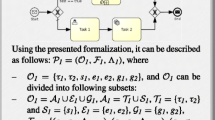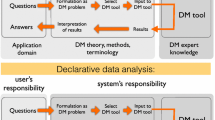Abstract
Business rules should be formulated in a comprehensible way to allow validation by business stakeholders. At the same time, rules must be precise enough precision to assure their correct implementation in computer applications. These opposing demands of business rule modeling are not easily reconciled. We outline a language to specify declarative business rules that is both compatible with practical demands, such as laid out in the Business Rules Manifesto. Our language is founded on the theory of Relation Algebra, and comprises just five language statements. They are orthogonal by design, making for a language that is suited for use by novice business rule modelers. The rules, employing a vocabulary as understood and explained by business stakeholders, are expressed in a comprehensible if-then syntax.
Access this chapter
Tax calculation will be finalised at checkout
Purchases are for personal use only
Similar content being viewed by others
References
Hay, D., Healy, K.A.: Defining Business Rules ~ What Are They Really?. Kluwer Academic Publishers, Boston (2000). www.businessrulesgroup.org/first_paper/BRG-whatisBR_3ed.pdf
Ross, R.G.: (ed.) Business Rules Manifesto (2003). www.businessrulesgroup.org
Bajwa, I.S., Lee, M.G., Bordbar, B.: SBVR business rules generation from natural language specification. In: AAAI Spring Symposium: AI for Business Agility (2011)
Kardasis, P., Loucopoulos, P.: Expressing and organising business rules. Inf. Softw. Technol. 46(11), 701–718 (2004)
Bjekovic, M., Proper, H.A,: Challenges of modelling landscapes. In: 3rd International Conference on BMSD, pp. 11–22 (2013)
Object Management Group. SBVR: Semantics of Business Vocabulary and Business Rules, Version 1.0 (2008). doc.omg.org/formal/08–01-02.pdf
Ross, R.G., Lam, G.S.W.: Building Business Solutions: Business Analysis with Business Rules. Business Rules Solutions LLC, Houston (2011)
Fuchs, N.E., Kaljurand, K., Kuhn, T.: Attempto controlled english for knowledge representation. In: Baroglio, C., Bonatti, P.A., Małuszyński, J., Marchiori, M., Polleres, A., Schaffert, S. (eds.) Reasoning Web. LNCS, vol. 5224, pp. 104–124. Springer, Heidelberg (2008)
Weigand, H., van den Heuvel, W.J., Hiel, M.: Business policy compliance in service-oriented systems. Inf. Syst. 36(4), 791–807 (2011)
FBM Working Group. Fact Based Modelling (2011). www.factbasedmodeling.eu/Data/sites/1/media/FBM1002WD06.pdf
Halpin, T.: Fact-orientation and conceptual logic. In: 15th IEEE International on Enterprise Distributed Object Computing Conference, pp. 14–19 (2011)
Quartel, D., Engelsman, W., et al.: A Goal-oriented requirements modelling language for enterprise architecture. In: Enterprise Distributed Object Computing (2009)
ArchiMate 2.1 Specification (2013). pubs.opengroup.org/architecture/archimate2-doc/
Lamrani, M., El Amrani, Y., Ettouhami, A.: On formalizing predefined OCL properties. Int. J. Comput. Inf. Sci. Eng. 7(1) (2013)
Beckner, M.: Custom business rules. In: BizTalk 2013 EDI for Health Care, pp. 105–116. Apress (2014)
Andreescu, A., Mircea, M.: issues and challenges of business rules modeling in software systems for business management. Informatica Economica 18(1), 162 (2014)
Boley, H., Paschke, A., Shafiq, O.: RuleML 1.0: the overarching specification of web rules. In: Dean, M., Hall, J., Rotolo, A., Tabet, S. (eds.) RuleML 2010. LNCS, vol. 6403, pp. 162–178. Springer, Heidelberg (2010)
Horrocks, I., Patel-Schneider, P.F., et al.: SWRL: a semantic web rule language combining OWL and RuleML. W3C Member submission (2004)
Akbari, I., Yan, B.: Visualizing SWRL Rules. ceur-ws.org
Poulovassilis, A., Papamarkos, G., Wood, P.T.: Event-condition-action rule languages for the semantic web. In: Grust, T., et al. (eds.) CEDBT 2006. LNCS, vol. 4254, pp. 855–864. Springer, Heidelberg (2006)
Hoare, C.A.R.: Communicating Sequential Processes. Prentice-hall, Englewood Cliffs (1985)
Wedemeijer, L.: A comparison of two business rules engineering approaches. In: 2nd International Symposium on Business Modeling and Software Design, pp. 113–121 (2012)
Maddux, R.D.: Relation algebras. Studies in Logic and the Foundations of Mathematics, vol. 150, pp. 289–525. Elsevier, Amsterdam (2006)
RuleSpeak 2014. RuleSpeak Sentence Forms. www.rulespeak.com
Moody, D.: Theoretical and practical issues in evaluating the quality of conceptual models. Data Knowl. Eng. 55(3), 243–276 (2005)
Michels, G.: IDE to learn business rules (provisional title Ph.D. thesis to be published) (2015)
Date, C.: Referential integrity. In: VLDB (1981)
Dietz, J.L.G.: On the nature of business rules. In: Dietz, J.L.G., Albani, A., Barjis, J. (eds.) CIAO! 2008 and EOMAS 2008. LNBIP, vol. 10, pp. 1–15. Springer, Heidelberg (2008)
Baader, F., Horrocks, I., Sattler, U.: Description logics. In: van Harmelen, F., Lifschitz, V., Porter, B. (eds.) Handbook of Knowledge Representation, pp. 135–179. Elsevier, Amsterdam (2008)
Grosof, B., Kifer, M.: Rulelog: Syntax and Semantics (2013). doi:10.1.1.359.9882
Rutledge, L.: From ontology to wiki generating cascadable default fresnel style from given ontologies. In: Workshop on Semantic Web Collaborative Spaces (SWCS 2013) (2013)
Schön, D.A.: Designing as reflective conversation with the materials of a design situation. Knowl.-Based Syst. 5(1), 3–14 (1992)
Edward, J.C., Timothy, R., Rick, K.: Role engineering: methods and standards. IT Prof. 13, 54–57 (2011)
Author information
Authors and Affiliations
Corresponding author
Editor information
Editors and Affiliations
Rights and permissions
Copyright information
© 2015 Springer International Publishing Switzerland
About this paper
Cite this paper
Wedemeijer, L. (2015). A Language to Specify Declarative Business Rules. In: Shishkov, B. (eds) Business Modeling and Software Design. BMSD 2014. Lecture Notes in Business Information Processing, vol 220. Springer, Cham. https://doi.org/10.1007/978-3-319-20052-1_5
Download citation
DOI: https://doi.org/10.1007/978-3-319-20052-1_5
Published:
Publisher Name: Springer, Cham
Print ISBN: 978-3-319-20051-4
Online ISBN: 978-3-319-20052-1
eBook Packages: Computer ScienceComputer Science (R0)




